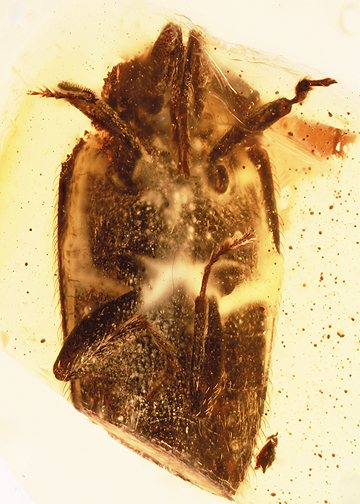Abstract
Early Cretaceous Wealden amber of the Isle of Wight (early Barremian, ~125 Ma) represents one of the oldest known fossiliferous ambers. Here we describe the first fossil beetle from the deposit, and first British coleopteran amber inclusion, the artematopodid Valdopogon simpsoni gen. et sp. nov. Despite its fragmentary nature, the fossil possesses a puzzling combination of characters unseen in modern Artematopodidae, namely equally long abdominal ventrites I and II, concave sutures between ventrites I–V, and absence of elytral striation. Valdopogon contributes to our understanding of the morphological evolution of this once diverse group of elateroid beetles.
References
- Azar, D., Perrichot, V., Néraudeau, D. & Nel, A. (2003) New psychodids from the Cretaceous ambers of Lebanon and France, with a discussion of Eophlebotomus connectens Cockerell, 1920 (Diptera, Psychodidae). Annals of the Entomological Society of America, 96, 117–126. https://doi.org/10.1603/0013-8746(2003)096[0117:NPFTCA]2.0.CO;2
- Baranov, V., Giłka, W., Zakrzewska, M. & Jarzembowski, E. (2019) New non-biting midges (Diptera: Chironomidae) from Lower Cretaceous Wealden amber of the Isle of Wight (UK). Cretaceous Research, 95, 138–145. https://doi.org/10.1016/j.cretres.2018.11.012
- Bray, P.S. & Anderson, K.B. (2008) The nature and fate of natural resins in the geosphere XIII: a probable pinaceous resin from the early Cretaceous (Barremian), Isle of Wight. Geochemical Transactions, 9, 3. https://doi.org/10.1186/1467-4866-9-3
- Cai, C.Y., Fu, Y.Z. & Huang, D.Y. (2020) A large artematopodid beetle (Coleoptera: Elateroidea: Artematopodidae) from the Early Cretaceous of China and its systematic position. Cretaceous Research, 105, 103986. https://doi.org/10.1016/j.cretres.2018.10.009
- Cai, C.Y., Tihelka, E., Giacomelli, M., Lawrence, J.F., Ślipiński, A., Kundrata, R., Yamamoto, S., Thayer, M.K., Newton, A.F., Leschen, R.A.B., Gimmel, M.L., Lü, L., Engel, M.S., Bouchard, P., Huang, D.Y., Pisani, D. & Donoghue, P.C.J. (2022) Integrated phylogenomics and fossil data illuminate the evolution of beetles. Royal Society Open Science, 9, 211771. https://doi.org/10.1098/rsos.211771
- Cai, C.Y., Lawrence, J.F., Ślipiński, A. & Huang, D.Y. (2015) Jurassic artematopodid beetles and their implications for the early evolution of Artematopodidae (Coleoptera). Systematic Entomology, 40, 779–788. https://doi.org/10.1111/syen.12131
- Crowson, R.A. (1973) On a new superfamily Artematopoidea of polyphagan beetles, with the definition of two new fossil genera from the Baltic Amber. Journal of Natural History, 7, 225–238. https://doi.org/10.1080/00222937300770181
- Delclòs, X., Peñalver, E., Barrón, E., Peris, D., Grimaldi, D.A., Holz, M., Labandeira, C.C., Saupe, E.E., Scotese, C.R., Solórzano-Kraemer, M.M., Álvarez-Parra, S., Arillo, A., Azar, D., Cadena, E.A., Dal Corso, J., Kvaček, J., Monleón-Getino, A., Nel, A., Peyrot, D., Bueno-Cebollada, C.A., Gallardo, A., González-Fernández, B., Goula, M., Jaramillo, C., Kania-Kłosok, I., López-Del Valle, R., Lozano, R.P., Meléndez, N., Menor-Salván, C., Peña-Kairath, C., Perrichot, V., Rodrigo, A., Sánchez-García, A., Santer, M., Sarto i Monteys, V., Uhl, D., Viejo, J.L. & Pérez-de la Fuente, R. (2023) Amber and the Cretaceous resinous interval. Earth-Science Reviews, 243, 104486. https://doi.org/10.1016/j.earscirev.2023.104486
- Douglas, H.B., Kundrata, R., Brunke, A.J., Escalona, H.E., Chapados, J.T., Eyres, J., Richter, R., Savard, K., Ślipiński, A., McKenna, D. & Dettman, J.R. (2021) Anchored phylogenomics, evolution and systematics of Elateridae: are all bioluminescent Elateroidea derived click beetles? Biology, 10, 451. https://doi.org/10.3390/biology10060451
- Gale, A. (2019) Correlation, age and significance of Turonian Chalk hardgrounds in southern England and northern France: The roles of tectonics, eustasy, erosion and condensation. Cretaceous Research, 103, 104164. https://doi.org/10.1016/j.cretres.2019.06.010
- Hörnschemeyer, T. (1998) New species of Electribius Crowson 1973 (Coleoptera: Artematopodidae) from Baltic amber. Paläontologische Zeitschrift, 72, 299–305. https://doi.org/10.1007/BF02988360
- Jarzembowski, E. (1995) The first insects in Cretaceous (Wealden) amber from the UK. Geology Today, 11, 41–42.
- Jarzembowski, E., Azar, D. & Nel, A. (2008) A new chironomid (Insecta: Diptera) from Wealden amber (Lower Cretaceous) of the Isle of Wight (UK). Geologica Acta, 6, 285–291. https://doi.org/10.1344/105.000000257
- Kundrata, R., Bocakova, M. & Bocak, L. (2014) The comprehensive phylogeny of the superfamily Elateroidea (Coleoptera: Elateriformia). Molecular Phylogenetics and Evolution, 76, 162–171. https://doi.org/10.1016/j.ympev.2014.03.012
- Lawrence, J.F. (2005) Brevipogon, a new genus of North American Artematopodidae (Coleoptera), with a key to world genera. Coleopterists Bulletin, 59, 223–236. https://doi.org/10.1649/749
- Lawrence, J.F. (2010) Artematopodidae Lacordaire, 1857. In: Leschen, R.A.B., Beutel, R.G. & Lawrence, J.F. (Eds), Handbuch der Zoologie/Handbook of Zoology. Band/Volume IV Arthropoda: Insecta Teilband/Part 38. Coleoptera, Beetles. Volume 2. Morphology and systematics (Polyphaga partim). W. DeGruyter, Berlin, pp. 42–47. https://doi.org/10.1515/9783110911213.42
- Li, Y.D., Huang, D.Y. & Cai, C.Y. (2021) Revisiting the systematic positions of two Notocupes species from the Lower Cretaceous of South China (Coleoptera: Polyphaga). Zootaxa, 5005 (1), 86–90. https://doi.org/10.11646/zootaxa.5005.1.7
- Li, Y.D., Kundrata, R., Huang, D.Y. & Cai, C.Y. (2022) First Artematopodidae from mid-Cretaceous amber of northern Myanmar (Coleoptera: Elateroidea). Zootaxa, 5129 (2), 257–271. https://doi.org/10.11646/zootaxa.5129.2.6
- McKenna, D.D., Wild, A.L., Kanda, K., Bellamy, C.L., Beutel, R.G., Caterino, M.S., Farnum, C.W., Hawks, D.C., Ivie, M.A., Jameson, M.L., Leschen, R.A.B., Marvaldi, A.E., Mchugh, J.V., Newton, A.F., Robertson, J.A., Thayer, M.K., Whiting, M.F., Lawrence, J.F., Ślipiński, A., Maddison, D.R. & Farrell, B.D. (2015) The beetle tree of life reveals that Coleoptera survived end-Permian mass extinction to diversify during the Cretaceous terrestrial revolution. Systematic Entomology, 40, 835–880. https://doi.org/10.1111/syen.12132
- Nicholas, C.J., Henwood, A.A. & Simpson, M. (1993) A new discovery of early Cretaceous (Wealden) amber from the Isle of Wight. Geological Magazine, 130, 847–850. https://doi.org/10.1017/S0016756800023207
- Peris, D., Ruzzier, E., Perrichot, V. & Delclòs, X. (2016) Evolutionary and paleobiological implications of Coleoptera (Insecta) from Tethyan-influenced Cretaceous ambers. Geoscience Frontiers, 7, 695–706. https://doi.org/10.1016/j.gsf.2015.12.007
- Perkovsky, E.E., Olmi, M., Müller, P., Guglielmino, A., Jarzembowski, E.A., Capradossi, L. & Rasnitsyn, A.P. (2021) A review of the fossil Embolemidae (Hymenoptera: Chrysidoidea), with description of seven new species and history of the family. Cretaceous Research, 121, 104708. https://doi.org/10.1016/j.cretres.2020.104708
- Selden, P.A. (2002) First British Mesozoic spider, from Cretaceous amber of the Isle of Wight, southern England. Palaeontology, 45, 973–983. https://doi.org/10.1111/1475-4983.00271
- Wu, H., Coty, D. & Ding, M. (2015) First artematopodid beetle in Mexican amber and its biogeographic implications (Coleoptera, Artematopodidae). Alcheringa, 39, 508–513. https://doi.org/10.1080/03115518.2015.1041306
- Zhang, S.Q., Che, L.H., Li, Y., Liang, D., Pang, H., Ślipiński, A. & Zhang, P. (2018) Evolutionary history of Coleoptera revealed by extensive sampling of genes and species. Nature Communications, 9, 205. https://doi.org/10.1038/s41467-017-02644-4


